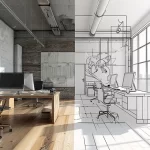Design Patent Drawings Preparation Guide for Patent Professionals
- June 7, 2024
- By Sarita Thomas
- Read 2 minutes
Understanding the nuances between design and utility patents is crucial for patent professionals who are engaged in patent prosecution work. Contrary to the utility patents that safeguard the functionality and operation of an invention, design patents focus solely on protecting its visual appearance. In this guide, we’ll look into the preparation of design patent drawings and key considerations patent professionals must consider to secure a good design patent protection for their clients’ innovations.
Understanding Design Patents
A design patent is granted to applicants who have conceived a new, original, and ornamental design for an article of manufacture. Unlike utility patents which protect how an invention is used and works, design patents exclusively protect the visual characteristics or aesthetics of a product and not its functionality. This means that design patents prevent others from copying the unique appearance of an article as opposed to a product’s functional or structural protection in utility patents.
Key Differences Between Design and Utility Patents
Several distinctions exist between design and utility patents. Some of these are listed here:
Term Duration: Design patents typically have a term of 15 years from the date of grant. Utility patents last for 20 years from the filing date.
Maintenance Fees: Design patents do not require maintenance fees. Utility patents require a maintenance fee that is paid at specific time intervals.
Claim Structure: Design patent applications include a single claim, while utility patent applications can feature multiple claims. These can be independent or dependent claims.
Examiner Discretion: The discretion to restrict between plural, distinct inventions lies with examiners for utility patents, while it is mandatory for design patents.
The Importance of Design Patent Drawings
The primary purpose of a design patent is to protect visual disclosure of the claimed design. These drawings must be clear, complete, and compliant with the disclosure requirements as outlined in 35 U.S.C. 112.
Guidelines for Design Patent Drawings
Each view of the drawings should be clearly labeled to indicate its representation (e.g., front elevation, top plan, perspective view).
The specification of a design patent may include descriptions clarifying elements not illustrated in the drawing, disclaiming portions of the article not shown, or denoting the nature and environmental use of the claimed design.
Drawings are typically rendered in black ink on white paper, adhering to the specifics outlined in 37 CFR §1.84(b)(1) and §1.152. Black and white photographs may also be used, but they must comply with the same standards.
While the USPTO primarily accepts black and white drawings or photographs, color may be permitted in specific cases. A petition must be filed, along with the necessary fee, to justify the inclusion of color photographs.
By adhering to these USPTO guidelines and ensuring the clarity and completeness of design patent drawings, patent professionals and attorneys can prepare secure design patent protection for their clients’ valuable creations.
If you are busy with other patent strategy work and do not have time to prepare drawings or if you need a patent drawings support team for making things more streamlined to you, please fill the form. “Professional Patent Drawings” team will reach out to help you develop the drawings for your case. At “Professional Patent Drawings”, the team has been delivering expert and high-quality patent drawings for the last 15 + years to US patent attorneys and in other countries. The team is trained by attorneys and is aware of the patent preparation guidelines.







